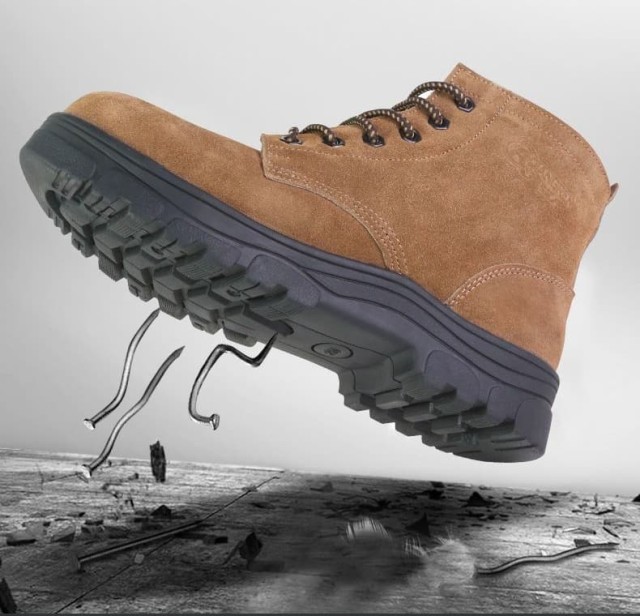Choosing the right safety footwear isn't just about compliance—it's about matching material properties to workplace hazards while maintaining comfort. This guide breaks down the key factors in selecting toe protection that aligns with regulatory standards and job-specific demands.
Industrial Footwear Selection Matrix
Regulatory Compliance Thresholds Across Industries
All safety footwear must meet ASTM F2413-18 standards, which mandate impact resistance (75 pound-force minimum), compression resistance, and other protective features. OSHA enforces these requirements under 29 CFR 1910.136, with violations commonly occurring when employers fail to provide ASTM-compliant footwear.
Key labels to recognize:
- "I" = Impact resistance (75 lbf)
- "C" = Compression resistance (2,500 lbf)
- "EH" = Electrical hazard protection
Material Science of Protective Toe Caps
Three primary materials dominate the market:
-
Steel Toes
- Highest impact resistance but conducts temperature extremes
- Triggers metal detectors, unsuitable for airports/secure facilities
-
Composite Toes
- 30% lighter than steel with comparable protection
- Non-metallic (passes metal detectors)
- Better thermal insulation but bulkier design
-
Alloy Toes
- Lighter than steel with similar strength
- Still conductive, limiting use in extreme temperatures
Ergonomic vs. Protective Priorities
Weight-to-Protection Ratios by Material
| Material | Avg. Weight per Pair | Relative Protection |
|---|---|---|
| Steel | ~3.5 lbs | Highest |
| Composite | ~2.4 lbs | Medium-High |
| Alloy | ~3.0 lbs | High |
For roles requiring mobility (e.g., warehouse pickers), composite toes reduce fatigue by ~15% over steel.
Climate Adaptation Factors
- Cold Environments: Composite toes prevent heat transfer, reducing frostbite risk versus metal options.
- High Heat: Steel toes can become uncomfortably hot in foundries or asphalt work.
Hazard-Specific Footwear Configuration
Impact Resistance Requirements by Job Function
- Construction: Steel/alloy toes for falling debris (meets ASTM "I" rating)
- Manufacturing: Composite sufficient for most factory settings
- Electrical Work: Non-metallic composites mandatory (EH-rated)
Electrical Hazard Considerations
Composite toes inherently protect against electrical currents, while steel toes require special insulation to meet EH standards.
Real-World Application Scenarios
Case Study: Manufacturing Floor vs. Oil Rig Needs
- Automotive Plant: Composite toes preferred—lighter for 12-hour shifts and no machinery interference.
- Oil Rig: Steel toes withstand heavy pipe drops but require thermal liners in Arctic conditions.
Security Personnel Protocols
Over 90% of安检 facilities prohibit steel toes due to metal detectors. Composite alternatives allow uninterrupted access.
Optimize Your Safety Footwear Inventory
3515 manufactures ASTM-compliant safety footwear tailored to your industry’s unique hazards. Whether you need lightweight composites for logistics teams or rugged steel toes for construction crews, our scalable solutions ensure protection without compromising productivity. [Contact 3515] to discuss bulk procurement options.
Products You Might Be Looking For:
Explore ASTM-compliant safety footwear options
Related Products
- Wholesale Customizable Suede Safety Boots - Puncture-Proof with Velcro Closure
- Wholesale Durable Camo Canvas Shoes with High-Traction Rubber Soles
- Puncture-Resistant Velcro Safety Boots for Wholesale & Custom Manufacturing
- Customizable Anti-Smash Safety Boots for Wholesale & Private Label Manufacturing
- Wholesale Mesh Steel Toe Safety Shoes with Dial Closure Factory Production
Related Articles
- How to Choose Work Boots That Match Your Industry's Safety Needs
- How to Choose Work Boots That Match Your Job Demands and Safety Needs
- Steel Toe Work Boots: Balancing Safety and Comfort for Demanding Jobs
- How to Extend Work Boot Lifespan: Science-Backed Care for Safety & Savings
- How to Choose Work Boot Materials for Maximum Safety and Durability



















